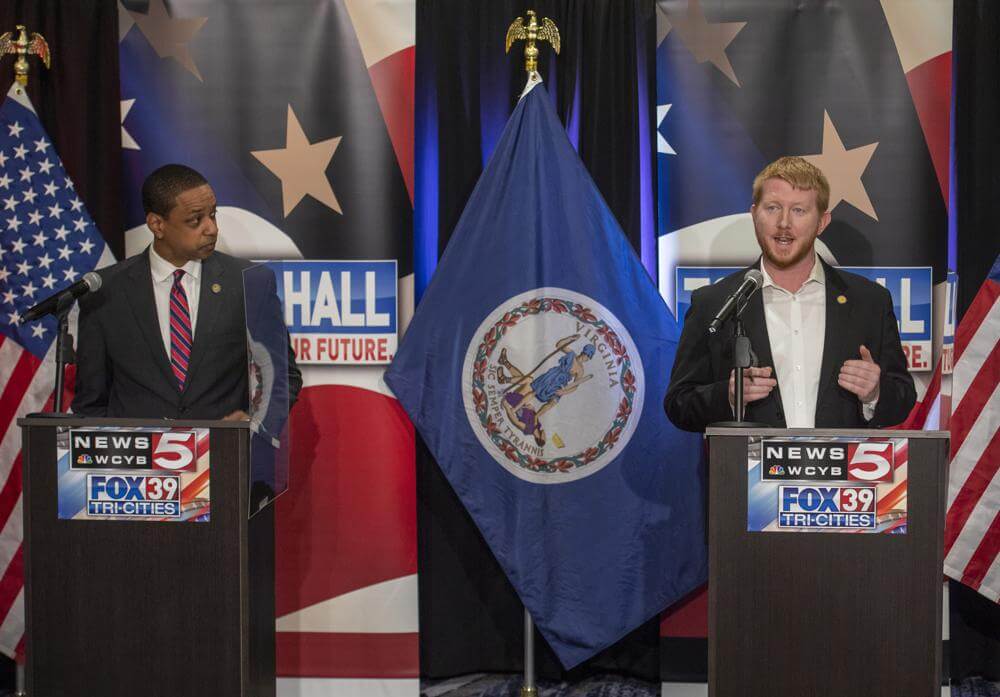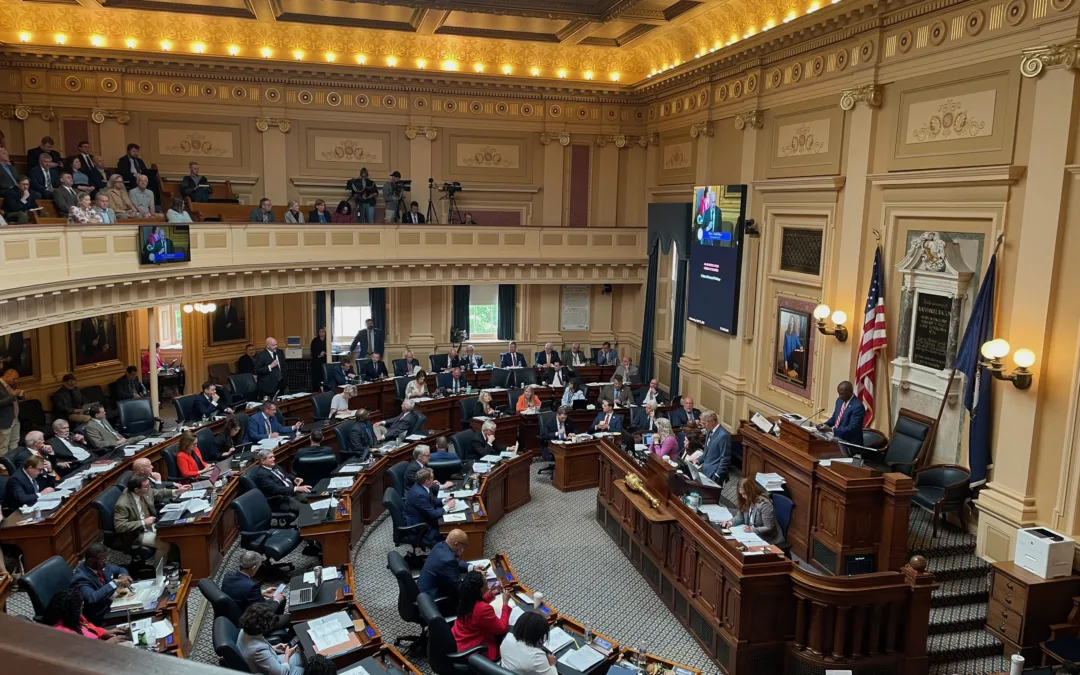
Democratic candidate for Governor of Virginia Lt. Gov. Justin Fairfax, left, listens as Del. Lee Carter speaks during a debate held in Bristol, Va., on Thursday, May 6, 2021. (David Crigger/Bristol Herald Courier via AP)
Candidates for governor all outline how they would solve Virginia’s broadband problem.
BRISTOL-How do you provide universal broadband access for Virginia? The pandemic and a focus on remote learning highlighted Virginia’s multiple problems in that area. Overall, just 53% of homes in the Commonwealth have broadband access. Eleven percent of Virginians don’t have internet access of any kind, according to the 2019 Commonwealth Connect report. So how do you fix that problem? Moderators opened the May 6 debate asking each Democratic candidate for governor that question.
Current lieutenant governor Justin Fairfax answered first, saying “we need to invest even more than we have been.” Fairfax acknowledged that Gov. Ralph Northam has set a goal of getting broadband for all Virginians by 2028.
“I believe we can do that even more quickly, by the end of the next term,” Fairfax said. “We have put $50 million per year into the Virginia Telecommunications Initiative, but we’ve [also] got to deal with public-private partnerships [and] last mile coverage.”
Fairfax mentioned public-private partnerships because private companies run Virginia’s internet infrastructure. The challenge is convincing them it’s worth spending $15 to $20 million to deliver high-speed internet to rural communities. That means installing lines and generally building a system that’s not cheap. The U.S. Department of Transportation estimates the average cost of installing broadband at $22,000 to $27,000 per mile. That includes the cable, the labor and equipment. The higher the elevation, the bigger the price tag, as the terrain makes it harder to install.
The Virginia Telecommunications Initiative also got mentioned a lot by each candidate. The program’s purpose is specifically to help fund broadband expansion to unserved areas. Virginia’s governor and General Assembly decide how much to set aside in each budget for the project.
Take a Page From The Past
That’s why other candidates said it’s time to use some different tools to solve the problem.
“We have been using this approach to broadband service for the last decade,” Del. Lee Carter said. “Trying to incentivize private corporations and the big telecoms to do the right thing and provide that last mile service. But just like electricity in rural areas in the early 20th century, we have not been able to get that broadband service to every address.”
Carter suggested taking a lesson from Virginia’s past, fixing this the same way rural America got electricity in the early 1900s.
“The government needs to just hire people to run the lines and spin that infrastructure off to nonprofit entities like the rural electric co-ops and municipal utilities,” Carter said.
State Sen. Jennifer McClellan took a different route. First, she said we need to identify which areas are unserved or underserved for internet access. Then we “work with our local governments to identify what is the right technology and what is the right model for this specific community,” McClellan said.
In some areas, a public-private partnership is the best fit. The government splits the cost with the company, making it more affordable to expand services. In some areas, she said, it makes more sense for the city or county to create its own internet utility. But too often in all these cases, it’s state government that’s the problem.
“The state too often has put barriers in the way,” McClellan said. “We need to be partners with our local government and partners with the federal government [to solve this]. [We need] to use the [federal] funds they are giving us now to expand and get the infrastructure in the ground.”
Existing Options and New Dollars
During her answer, former Del. Jennifer Carroll Foy pointed out there was an existing option that could be used. During the 2020 regular session, Carroll Foy sponsored HB 831. The bill, which passed and was signed into law on April 10, 2020 by Gov. Northam, lets current utility easements be used for broadband. Basically, you already have easements in these rural areas for power, water and other utilities. Carroll Foy’s bill allows companies to run broadband cable through those same easements, avoiding the cost linked with running lines.
Beyond that, Carroll Foy promised “as the next governor, I will be bolder. I will put $50 million into the Virginia Telecommunications Initiative and create public-private partnerships so we can have virtual learning here in Virginia.”
The final candidate, former Virginia governor Terry McAuliffe, did two things. First, he promised as governor, every single home in Virginia would have broadband access by the end of his term. As for how that would happen, he offered a couple solutions. First, he would expand the amount paid into the Virginia Telecommunications Initiative to $75 million.
Second, he pointed out that Virginia, as well as local cities and counties, will have quite a bit of money coming from President Biden’s American Rescue Plan in the coming months.
“The federal government has already given Virginia $4 billion,” McAuliffe said. “Localities are getting $2.7 billion, K-12 is getting $2.1 billion. That’s a lot of money to get this fixed.”
Brian Carlton is Dogwood’s managing editor. You can reach him at [email protected].
Politics

Youngkin, Democrats to start over on budget talks
The Republican governor stood with Democratic leaders in the General Assembly on Wednesday in a bid to ease tensions over their budget debate....

VIDEO: Domestic abuse victims speak out against the gun law bills Gov. Glenn Youngkin vetoed
Senate Bill 47 and House Bill 46 aim to close the loophole that allows offenders to transfer their firearms to someone else instead of relinquishing...
Local News

Virginia verses: Celebrating 5 poetic icons for National Poetry Month
There’s no shortage of great writers when it comes to our commonwealth. From the haunting verses of Edgar Allan Poe, who found solace in Richmond's...

Join the fun: Recapping Family Literacy Night’s storybook adventures
When’s the last time you read a book aloud with a loved one? If it’s difficult to answer that question, then maybe it’s time to dust off that TBR...




